Low-Velocity Impact Response on Glass Fiber Reinforced 3D Integrated Woven Spacer Sandwich Composites
Abstract
:1. Introduction
2. Materials and Methods
3. Results and Discussion
3.1. Force Deformation Curves
3.2. Damage Morphology and Energy Absorption
4. Conclusions
Author Contributions
Funding
Institutional Review Board Statement
Informed Consent Statement
Data Availability Statement
Conflicts of Interest
References
- Aboura, Z.; Khellil, K.; Benzeggagh, M.L.; Bouden, A.; Ayad, R. A New Generation of 3D Composite Materials: Advantage and Disadvantage. In Damage and Fracture Mechanics; Boukharouba, T., Elboujdaini, M., Pluvinage, G., Eds.; Springer: Dordrecht, The Netherlands, 2009; pp. 473–483. ISBN 978-90-481-2668-2. [Google Scholar]
- Bilisik, K.; Kaya, G.; Ozdemir, H.; Erdogan, M.K.A.G. Applications of Glass Fibers in 3D Preform Composites; IntechOpen: London, UK, 2018; ISBN 978-1-78923-177-9. [Google Scholar]
- Pankow, M.R.; Waas, A.M. 3D Textile Composites: Mechanical Properties. In Wiley Encyclopedia of Composites; John Wiley & Sons, Inc.: Hoboken, NJ, USA, 2012; p. weoc257. ISBN 978-1-118-09729-8. [Google Scholar]
- Jia, L.X.; Wang, R.; Liu, J.M. Design and Property Analysis of Woven Spacer Fabric Sandwich Panels. Adv. Mater. Res. 2011, 332–334, 747–751. [Google Scholar] [CrossRef]
- Li, M.; Wang, S.; Zhang, Z.; Wu, B. Effect of Structure on the Mechanical Behaviors of Three-Dimensional Spacer Fabric Composites. Appl. Compos. Mater. 2009, 16, 1–14. [Google Scholar] [CrossRef]
- Ma, P.; Jiang, G.; Gao, Z. 11 The Three Dimensional Textile Structures for Composites. In Advanced Composite Materials: Properties and Applications; De Gruyter Open: Berlin, Germany, 2017; pp. 497–526. ISBN 978-3-11-057443-2. [Google Scholar]
- Wang, S.K.; Li, M.; Gu, Y.Z.; Zhang, Z.G.; Wu, B.M. Mechanical Reinforcement of Three-Dimensional Spacer Fabric Composites. Mater. Sci. Forum 2010, 654–656, 2604–2607. [Google Scholar] [CrossRef]
- Zhu, L.; Lyu, L.; Zhang, X.; Wang, Y.; Guo, J.; Xiong, X. Bending Properties of Zigzag-Shaped 3D Woven Spacer Composites: Experiment and FEM Simulation. Materials 2019, 12, 1075. [Google Scholar] [CrossRef] [PubMed] [Green Version]
- Zhang, M.; Wang, X.; Liu, S.; Li, F.; Wu, G. Effects of Face Sheet Structure on Mechanical Properties of 3D Integrated Woven Spacer Composites. Fibers Polym. 2020, 21, 1594–1604. [Google Scholar] [CrossRef]
- Wang, S.; Li, M.; Zhang, Z.; Wu, B. Properties of Facesheet-Reinforced 3-D Spacer Fabric Composites and the Integral Multi-Facesheet Structures. J. Reinf. Plast. Compos. 2010, 29, 793–806. [Google Scholar] [CrossRef]
- Neje, G.; Behera, B.K. Investigation of Mechanical Performance of 3D Woven Spacer Sandwich Composites with Different Cell Geometries. Compos. Part B Eng. 2019, 160, 306–314. [Google Scholar] [CrossRef]
- Neje, G.; Behera, B.K. Influence of Cell Geometrical Parameters on the Mechanical Properties of 3D Integrally Woven Spacer Sandwich Composites. Compos. Part B Eng. 2020, 182, 107659. [Google Scholar] [CrossRef]
- Hu, Y.; Li, W.; Fan, H.; Sun, F.; Ouyang, J.; Qu, Z.; Kuang, N. Experimental Investigations on the Failures of Woven Textile Sandwich Panels. J. Thermoplast. Compos. Mater. 2017, 30, 196–224. [Google Scholar] [CrossRef]
- Fan, H.; Zhou, Q.; Yang, W.; Jingjing, Z. An Experiment Study on the Failure Mechanisms of Woven Textile Sandwich Panels under Quasi-Static Loading. Compos. Part B Eng. 2010, 41, 686–692. [Google Scholar] [CrossRef]
- Kus, A.; Durgun, I.; Ertan, R. Experimental Study on the Flexural Properties of 3D Integrated Woven Spacer Composites at Room and Subzero Temperatures. J. Sandw. Struct. Mater. 2018, 20, 517–530. [Google Scholar] [CrossRef]
- Jin, F.; Chen, H.; Zhao, L.; Fan, H.; Cai, C.; Kuang, N. Failure Mechanisms of Sandwich Composites with Orthotropic Integrated Woven Corrugated Cores: Experiments. Compos. Struct. 2013, 98, 53–58. [Google Scholar] [CrossRef]
- Sadighi, M.; Hosseini, S.A. Finite Element Simulation and Experimental Study on Mechanical Behavior of 3D Woven Glass Fiber Composite Sandwich Panels. Compos. Part B Eng. 2013, 55, 158–166. [Google Scholar] [CrossRef]
- Neje, G.; Behera, B. Geometrical Modeling of 3D Woven Spacer Fabrics as Reinforcement for Lightweight Sandwich Composites. J. Text. Inst. 2018, 110, 732–739. [Google Scholar] [CrossRef]
- Judawisastra, H.; Sayyu, C.T.; Taufiq, D.I. Improvement of Flatwise Compression Properties on 10 Mm Thickness 3D Woven Glass Fiber-Polyester Sandwich Composite by Means of Polyurethane Foam Injection; AIP Publishing: College Park, MD, USA, 2020; p. 040007. [Google Scholar]
- Manjunath, R.N.; Khatkar, V.; Behera, B.K. Influence of Augmented Tuning of Core Architecture in 3D Woven Sandwich Structures on Flexural and Compression Properties of Their Composites. Adv. Compos. Mater. 2020, 29, 317–333. [Google Scholar] [CrossRef]
- Jia, L.; Tian, F.; Liu, J.; Yan, R.; Pan, J. RTM Technology of Woven Spacer Fabric Reinforced Sandwich Composite Panels. IOP Conf. Ser. Mater. Sci. Eng. 2018, 382, 032057. [Google Scholar] [CrossRef] [Green Version]
- Behera, B.K.; Dash, B.P. Mechanical Behavior of 3D Woven Composites. Mater. Des. 2015, 67, 261–271. [Google Scholar] [CrossRef]
- Tripathi, L.; Chowdhury, S.; Behera, B.K. Modelling and Simulation of Compression Behaviour of 3D Woven Hollow Composite Structures Using FEM Analysis. Text. Leather Rev. 2020, 3, 6–18. [Google Scholar] [CrossRef] [Green Version]
- Varghese, J.T.; Madara, S.R.; Selvan, M.C.P. Review on the characteristical behavior of advanced 3d spacer composites. Int. J. Mech. Prod. Eng. Res. Dev. 2017, 7, 387–394. [Google Scholar]
- Shiah, Y.C.; Tseng, L.; Hsu, J.C.; Huang, J.H. Experimental Characterization of an Integrated Sandwich Composite Using 3D Woven Fabrics as the Core Material. J. Thermoplast. Compos. Mater. 2004, 17, 229–243. [Google Scholar] [CrossRef]
- Li, D.; Jiang, N.; Jiang, L.; Zhao, C. Static and Dynamic Mechanical Behavior of 3D Integrated Woven Spacer Composites with Thickened Face Sheets. Fibers Polym. 2016, 17, 460–468. [Google Scholar] [CrossRef]
- Wang, L.; Zhang, K.; Farha, F.I.; Ma, H.; Qiu, Y.; Xu, F. Compressive Strength and Thermal Insulation Properties of the 3D Woven Spacer Composites with Connected Spacer Yarn Structure. J. Mater. Sci. 2020, 55, 2380–2388. [Google Scholar] [CrossRef]
- Li, D.; Zhao, C.; Jiang, N.; Jiang, L. Experimental Study on the Charpy Impact Failure of 3D Integrated Woven Spacer Composite at Room and Liquid Nitrogen Temperature. Fibers Polym. 2015, 16, 875–882. [Google Scholar] [CrossRef]
- Hosseini, S.A.; Sadighi, M.; Maleki Moghadam, R. Low-Velocity Impact Behavior of Hollow Core Woven Sandwich Composite: Experimental and Numerical Study. J. Compos. Mater. 2015, 49, 3285–3295. [Google Scholar] [CrossRef]
- Hosur, M.; Al- Mayahi, M.; Jeelani, S. Manufacturing and Low-Velocity Impact Characterization of Foam Filled 3-D Integrated Core Sandwich Composites with Hybrid Face Sheets. Compos. Struct. Compos. Struct. 2005, 69, 167–181. [Google Scholar] [CrossRef]
- Dubary, N.; Taconet, G.; Bouvet, C.; Vieille, B. Influence of Temperature on the Impact Behavior and Damage Tolerance of Hybrid Woven-Ply Thermoplastic Laminates for Aeronautical Applications. Compos. Struct. 2017, 168, 663–674. [Google Scholar] [CrossRef] [Green Version]
- Andrew, J.J.; Srinivasan, S.M.; Arockiarajan, A.; Dhakal, H.N. Parameters Influencing the Impact Response of Fiber-Reinforced Polymer Matrix Composite Materials: A Critical Review. Compos. Struct. 2019, 224, 111007. [Google Scholar] [CrossRef]
- Saghafi, H.; Fotouhi, M.; Minak, G. Improvement of the Impact Properties of Composite Laminates by Means of Nano-Modification of the Matrix—A Review. Appl. Sci. 2018, 8, 2406. [Google Scholar] [CrossRef] [Green Version]
- Vieira, L.M.G.; Dobah, Y.; dos Santos, J.C.; Panzera, T.H.; Campos Rubio, J.C.; Scarpa, F. Impact Properties of Novel Natural Fibre Metal Laminated Composite Materials. Appl. Sci. 2022, 12, 1869. [Google Scholar] [CrossRef]
- Zhu, L.; Rahman, M.B.; Wang, Z. Effect of Structural Differences on the Mechanical Properties of 3D Integrated Woven Spacer Sandwich Composites. Materials 2021, 14, 4284. [Google Scholar] [CrossRef] [PubMed]
- Ismail, M.F.; Sultan, M.T.H.; Hamdan, A.; Shah, A.U.M.; Jawaid, M. Low Velocity Impact Behaviour and Post-Impact Characteristics of Kenaf/Glass Hybrid Composites with Various Weight Ratios. J. Mater. Res. Technol. 2019, 8, 2662–2673. [Google Scholar] [CrossRef]
- Cao, W.; Zhang, J.; Sun, B.; Gu, B. X-Ray Tomography and Numerical Study on Low-Velocity Impact Damages of Three-Dimensional Angle-Interlock Woven Composites. Compos. Struct. 2019, 230, 111525. [Google Scholar] [CrossRef]
- Park, H.; Kong, C. Experimental Study on Barely Visible Impact Damage and Visible Impact Damage for Repair of Small Aircraft Composite Structure. Aerosp. Sci. Technol. 2013, 29, 363–372. [Google Scholar] [CrossRef]
- D30 Committee. Test Method for Measuring the Damage Resistance of a Fiber-Reinforced Polymer Matrix Composite to a Drop-Weight Impact Event; ASTM International: West Conshohocken, PA, USA, 2012. [Google Scholar]
- Jayaram, R.; Nagarajan, V.; Kumar, K.V. Low Velocity Impact and Compression after Impact Behaviour of Polyester Pin-Reinforced Foam Filled Honeycomb Sandwich Panels. J. Sandw. Struct. Mater. 2021, 24, 157–173. [Google Scholar] [CrossRef]
- Atas, C.; Sevim, C. On the Impact Response of Sandwich Composites with Cores of Balsa Wood and PVC Foam. Compos. Struct. 2010, 93, 40–48. [Google Scholar] [CrossRef]
- Azimpour shishevan, F.; Akbulut, H.; Mohtadi Bonab, M.A. Low Velocity Impact Behavior of Basalt Fiber-Reinforced Polymer Composites. J. Mater. Eng. Perform. 2017, 26, 2890–2900. [Google Scholar] [CrossRef]

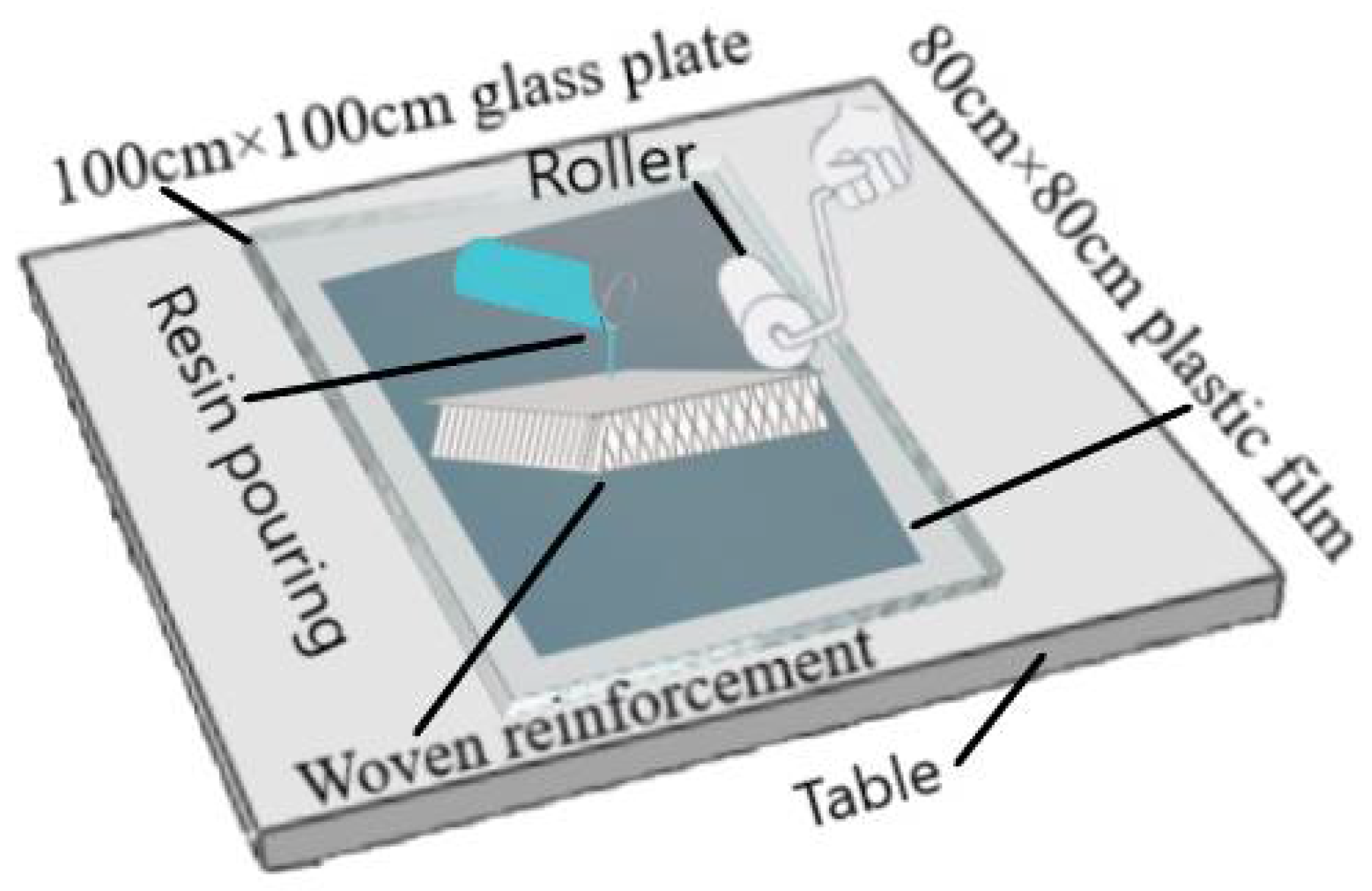
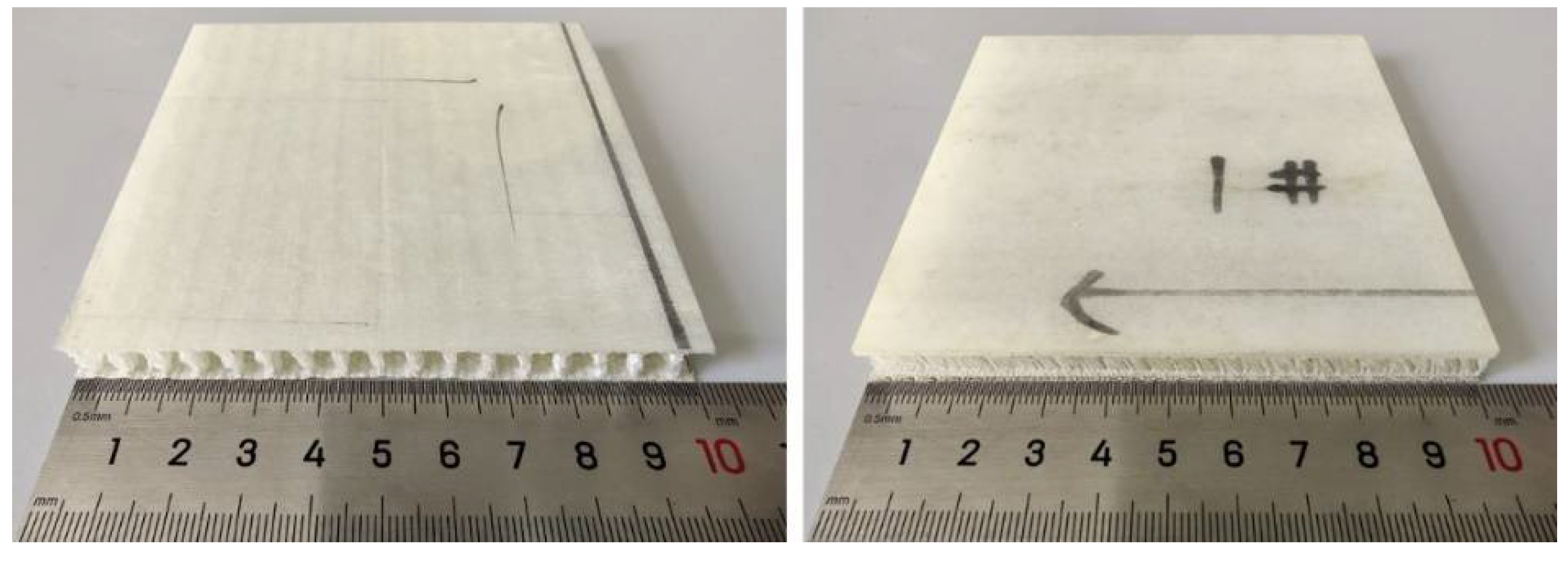
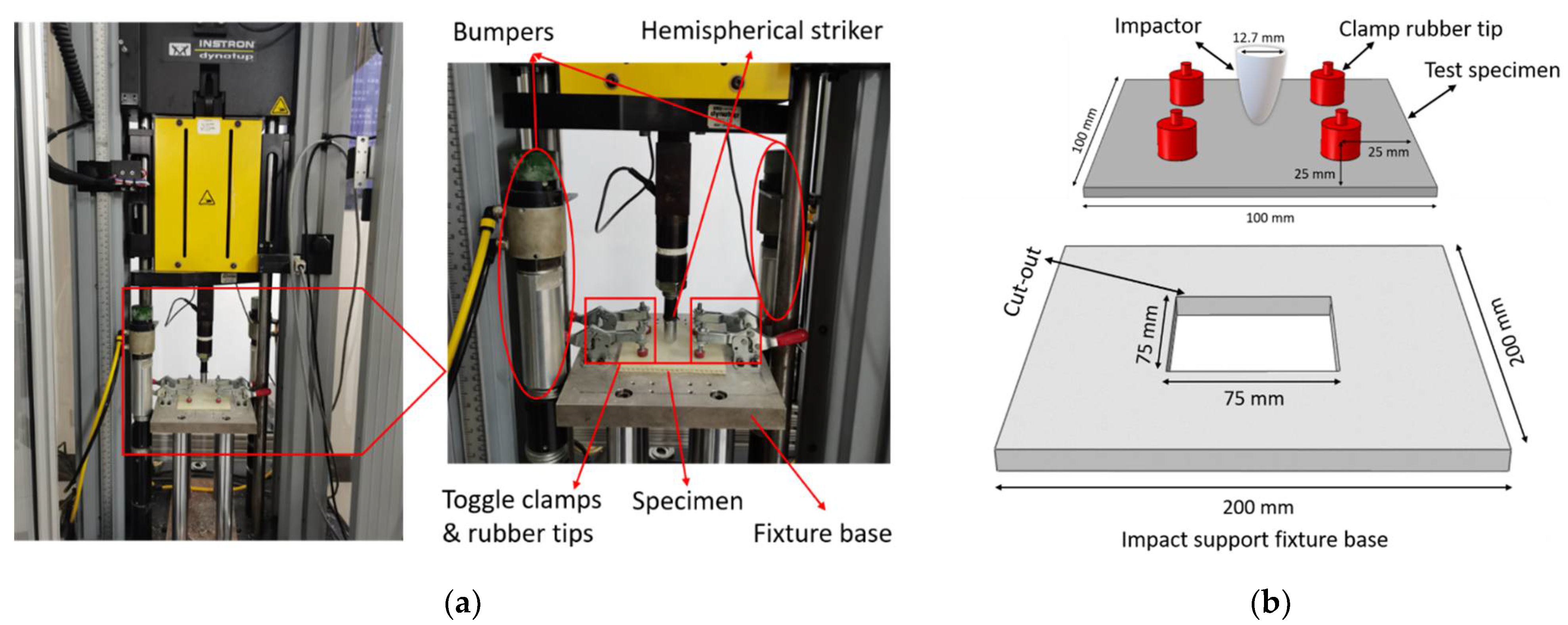
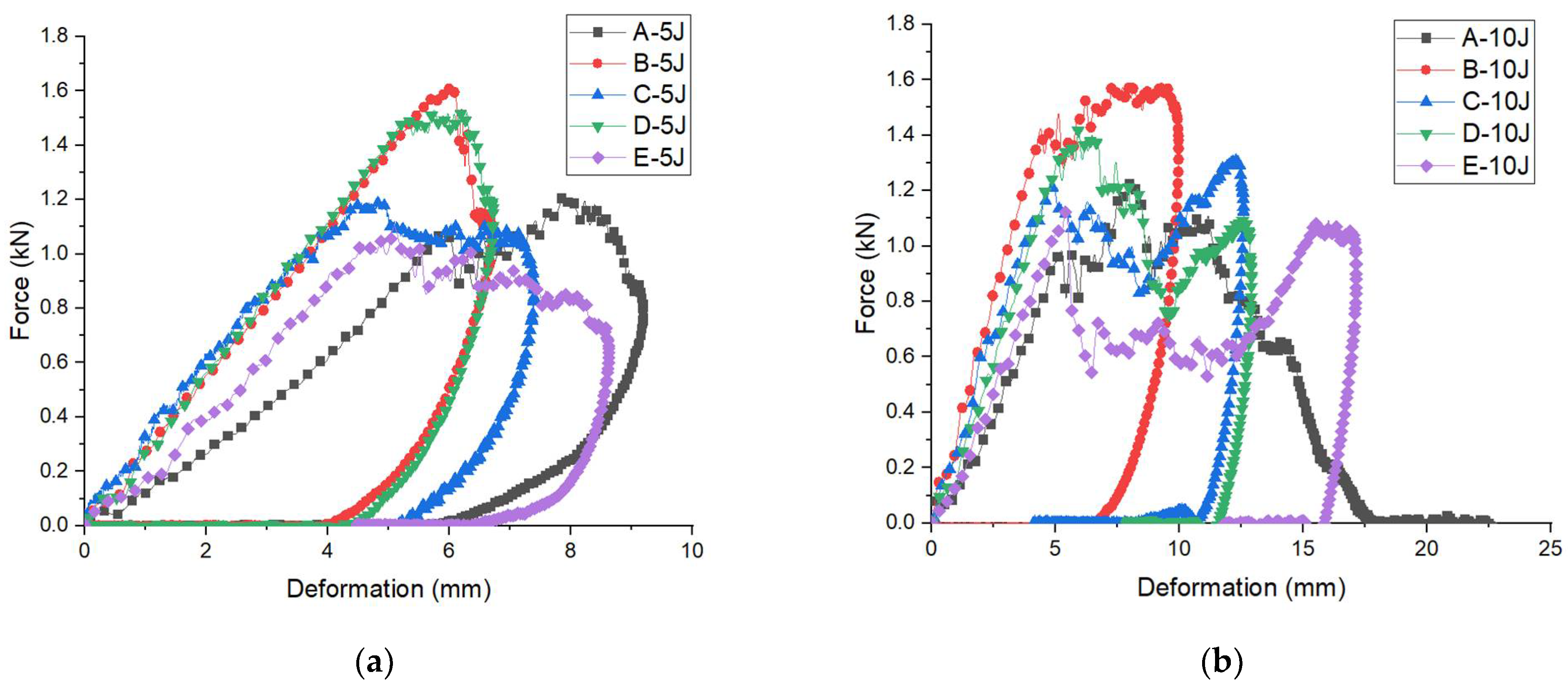
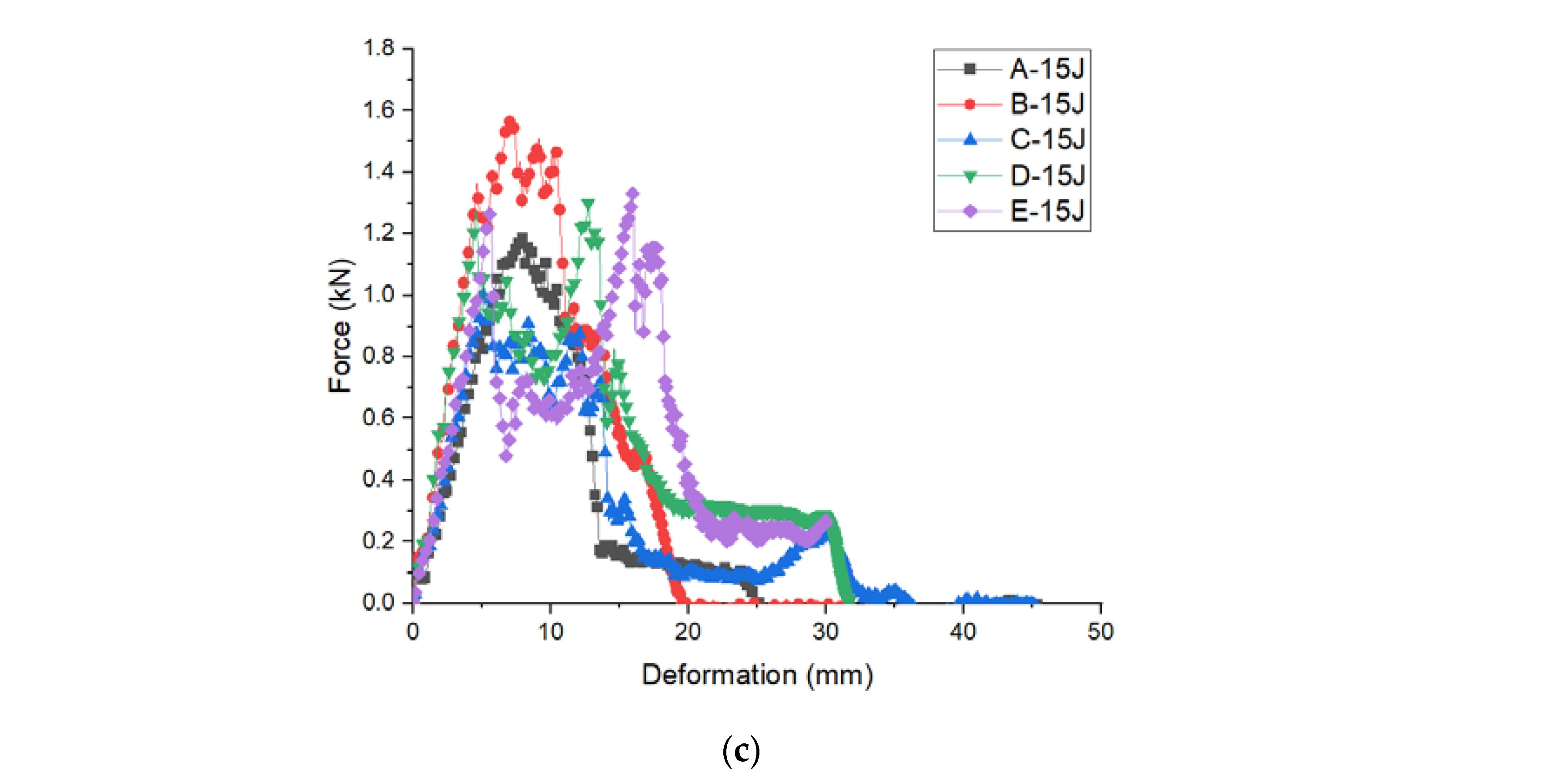
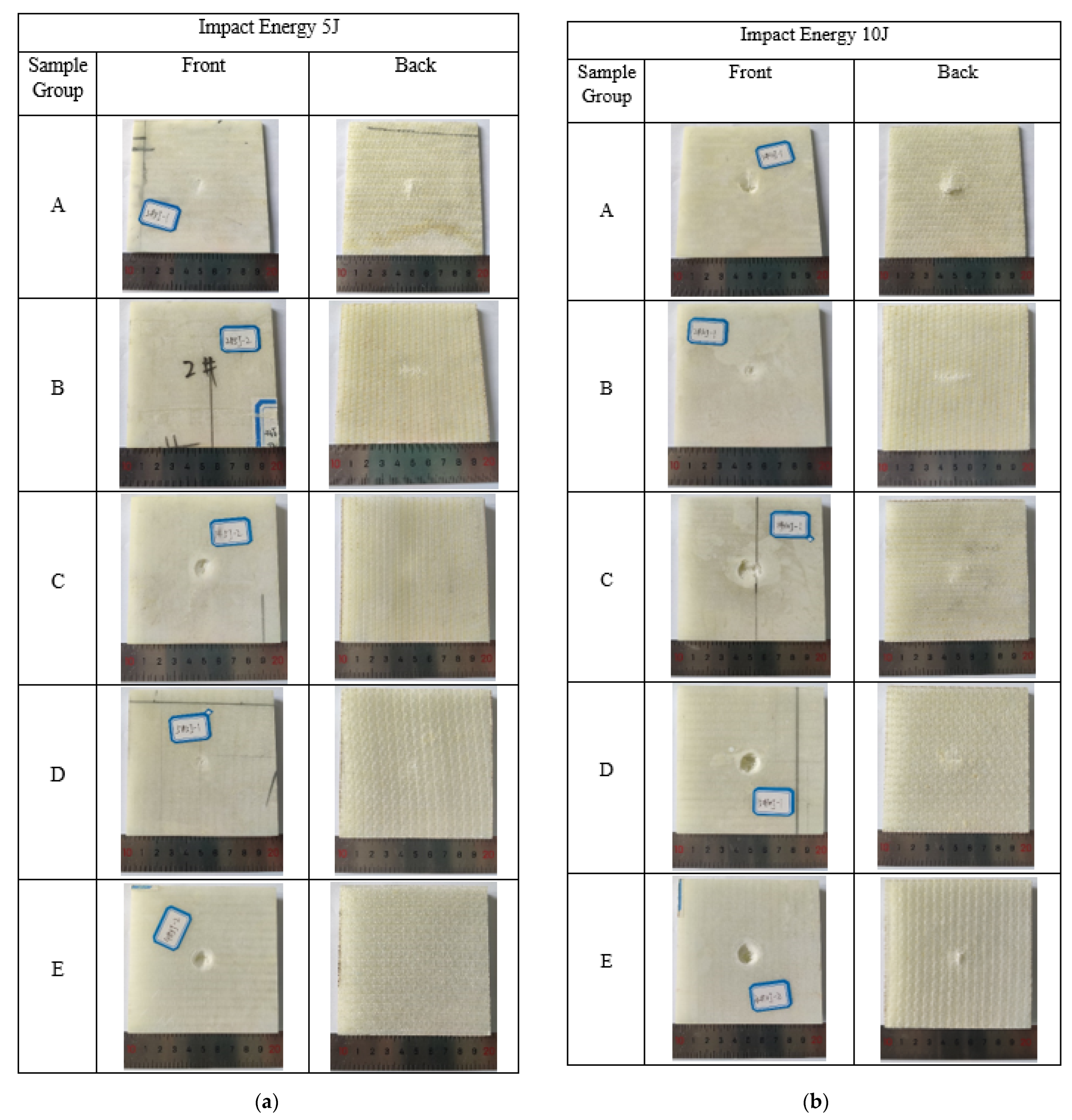
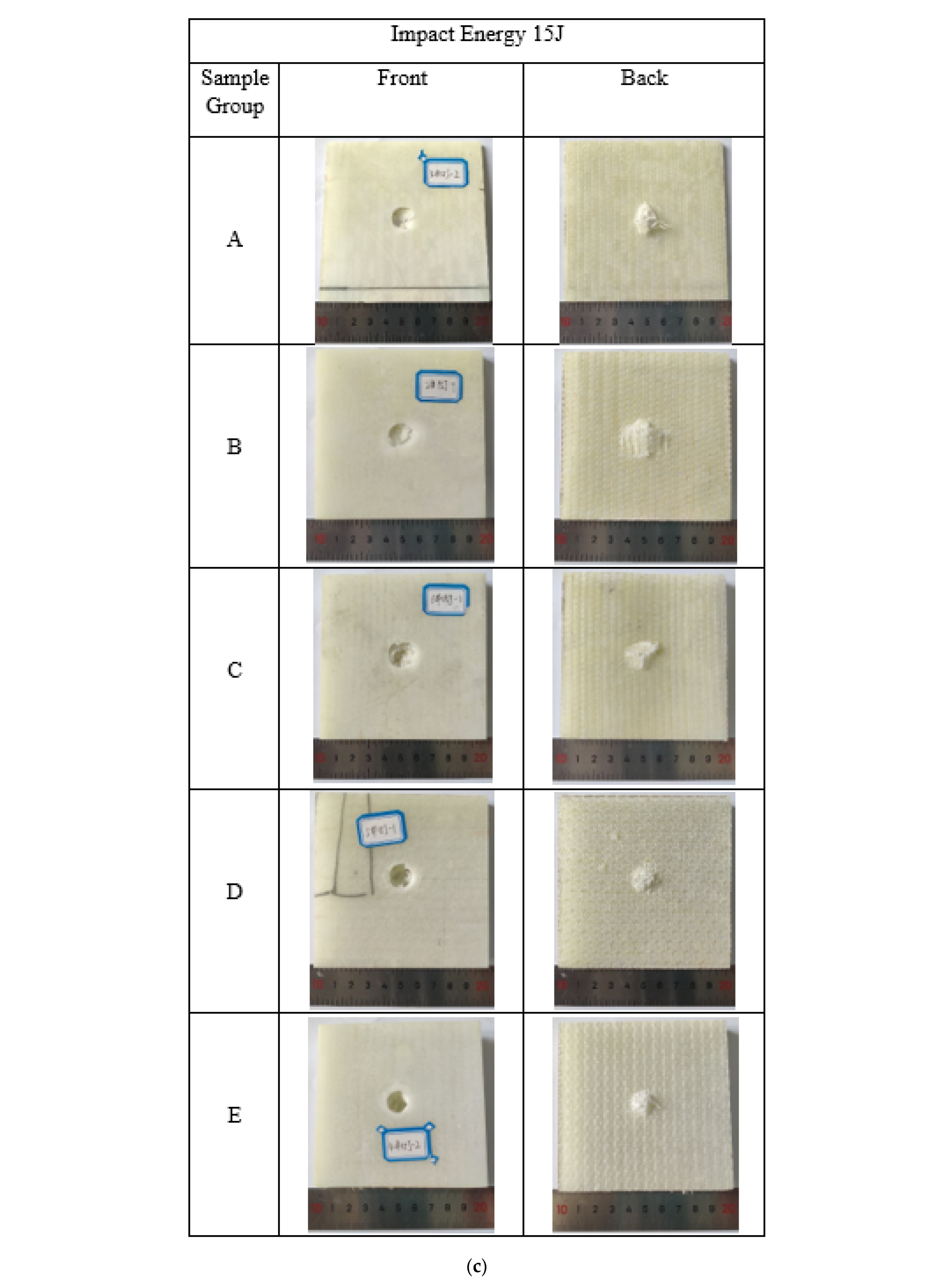


| Reinforcement Fabric Specifications | A | B | C | D | E |
|---|---|---|---|---|---|
| Core height (mm) | 3.0 | 5.0 | 8.0 | 10.0 | 12.0 |
| Top and bottom face sheet thickness (mm) | 0.36 | 0.36 | 0.36 | 0.58 | 0.58 |
| Fabric weight (g/m2) | 720 | 810 | 920 | 1440 | 1440 |
| Composite samples specifications | A | B | C | D | E |
| Total height (mm) | 3.40 | 5.42 | 8.69 | 10.60 | 12.62 |
| Core height (mm) | 2.17 | 4.19 | 7.46 | 9.37 | 11.39 |
| Top face sheet thickness (mm) | 0.75 | 0.75 | 0.75 | 1.10 | 1.10 |
| Bottom face sheet thickness (mm) | 0.48 | 0.48 | 0.48 | 0.80 | 0.80 |
| Warp piles density/inch | 3 | 3 | 3 | 2 | 2 |
| Weft piles density/inch | 12 | 12 | 12 | 10 | 10 |
| Composite weight (g/m2) | 1510 | 1680 | 1900 | 2930 | 3060 |
| Sample Group | Impact Energy (5 J) | Impact Energy (10 J) | Impact Energy (15 J) | |||
|---|---|---|---|---|---|---|
| Peak Force (kN) | Max. Deformation (mm) | Peak Force (kN) | Max. Deformation (mm) | Peak Force (kN) | Max. Deformation (mm) | |
| A | 1.23 | 9.20 | 1.24 | 22.63 | 1.19 | 45.37 |
| B | 1.61 | 6.71 | 1.58 | 9.97 | 1.58 | 33.02 |
| C | 1.20 | 7.40 | 1.31 | 12.59 | 1.00 | 45.28 |
| D | 1.53 | 6.72 | 1.42 | 12.91 | 1.30 | 31.70 |
| E | 1.10 | 8.63 | 1.13 | 17.14 | 1.33 | 30.00 |
Publisher’s Note: MDPI stays neutral with regard to jurisdictional claims in published maps and institutional affiliations. |
© 2022 by the authors. Licensee MDPI, Basel, Switzerland. This article is an open access article distributed under the terms and conditions of the Creative Commons Attribution (CC BY) license (https://creativecommons.org/licenses/by/4.0/).
Share and Cite
Rahman, M.B.; Zhu, L. Low-Velocity Impact Response on Glass Fiber Reinforced 3D Integrated Woven Spacer Sandwich Composites. Materials 2022, 15, 2311. https://doi.org/10.3390/ma15062311
Rahman MB, Zhu L. Low-Velocity Impact Response on Glass Fiber Reinforced 3D Integrated Woven Spacer Sandwich Composites. Materials. 2022; 15(6):2311. https://doi.org/10.3390/ma15062311
Chicago/Turabian StyleRahman, Mahfuz Bin, and Lvtao Zhu. 2022. "Low-Velocity Impact Response on Glass Fiber Reinforced 3D Integrated Woven Spacer Sandwich Composites" Materials 15, no. 6: 2311. https://doi.org/10.3390/ma15062311
APA StyleRahman, M. B., & Zhu, L. (2022). Low-Velocity Impact Response on Glass Fiber Reinforced 3D Integrated Woven Spacer Sandwich Composites. Materials, 15(6), 2311. https://doi.org/10.3390/ma15062311






